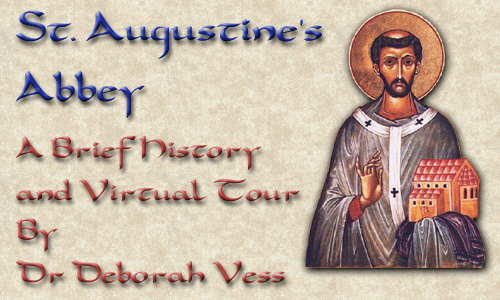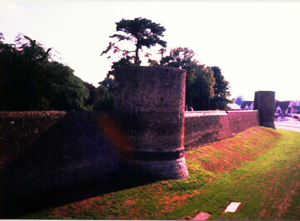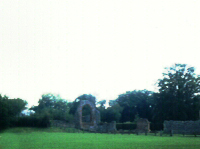
|
|
The First Roman Mission to England: St. Augustine
of Canterbury After Augustine: Conflicts with Christ's Church Pictorial Tour of the ruins of St. Augustine's Abbey The First Roman Mission to England: St. Augustine of CanterburyThe first Roman Catholic mission to England in 596 C.E. came at the request of Pope Gregory the Great. Gregory the Great was a Benedictine monk, and chose his missionaries from among his fellow brethren at his own monastery of St. Andrew. Gregory made Augustine, the prior (not to be confused with St. Augustine of Hippo), leader of the group, and in 596 C.E. they left for the wild and barbaric land of the heathen Anglo-Saxons. When they arrived in Provence, stories of the barbaric Anglo-Saxons and the dangers of crossing the channel prompted them to return to the safety of Rome. Gregory insisted that they leave again, and they landed on the Isle of Thanet in the territory of King Ethelbert of Kent. Augustine sent word of their arrival to Ethelbert, who received them under and oak tree and gave them permission to preach to his people. Augustine baptized Ethelbert on Pentecost in 597 C.E., and was consecrated bishop of the English in Gaul by the metropolitan of Arles, St. Virgilius. Many of Ethelbert;s subjects were baptized that Christmas, and Augustine sent his monks Laurence and Peter back to Rome to report on the mission and to ask for further advice and instructions. Gregory sent them back with the pallium for Augustine and more missionaries, including St. Paulinus, who later converted the Northumbrian Edwin of Northumbria. Gregory advised Augustine to respect the customs of the Anglo-Saxons, but to replace pagan festivals with feast days of saints and also to consecrate pagan sanctuaries to Christ. Augustine established his headquarters in Canterbury. Here he rebuilt an old church, which became Christ's Church and the center of his monastery there. The Norman Canterbury Cathedral now occupies this same site.
Augustine also founded another monastery outside the walls of Canterbury, which he consecrated to Sts. Peter and Paul. This foundation later became known as St. Augustine's Abbey. From these centers, he attempted to persuade the British bishops to help him evangelize the Anglo-Saxons, and also to unite their practices with those of the Roman Church. Augustine met with the British bishops in Wessex at a place known today as Augustine's oak. They refused to follow Roman practices, and Augustine predicted that if "they would not accept peace with their brethren, they should have war with their enemies" (Bede, Ecclesiastical History). Ten years after Augustine's death, the Northumbrian King Ethelfrith massacred the Britons at Chester. During Augustine's lifetime he established sees in London and Rochester as well as in Canterbury. He died on May 26, 605 C.E.. Although Kent would quickly relapse into paganism after the death of Ethelbert, missionaries from Augustine's party would convert the Northumbrians and, at the Synod of Whitby in 664 C.E., Roman Catholic Christianity and its practices would triumphantly unify the English church. After Augustine: Conflicts with Christ's ChurchAlthough St. Augustine's Christ Church would quickly become the center of the English Church, especially after the canonization of Becket in 1173, St. Augustine's Abbey, originally known as the Sts. Peter and Paul monastery, continued to play an important role in the English church. One of Augustine's successors, Theodore, was very instrumental in helping to establish Roman Catholic practices in Britain. Theodore was abbot for two year of Augustine's Sts. Peter and Paul monastery. . During the dark ages which followed the death of Augustine, many monastic communities became communities of canons. This was likely true of even Christ Church. St. Augustine's Abbey was one of the few that probably did not drift away from monastic life. It importance in this period is indicated by the fact that King Aethelstan gave the abbey a gift on the day of his coronation, which established a long tradition of immunity from the jurisdiction of episcopal authority. During the Norman period, St. Augustine's was involved in many disputes with the church hierarchy over its right of exemption. St. Augustine's exemption from episcopal jurisdiction brought it into continuous conflict with Christ Church, whose abbot was archbishop. Several papal bulls supported the independence of St. Augustine's, making it accountable only to the pope. St. Augustine's also held the Isle of Thanet, the place where the first Roman mission under Augustine of Canterbury had landed in 596. In the late twelfth century, the Abbey's insistence on its independence was troublesome to the powerful Archbishop Lanfranc. Lanfranc was uncomfortable with allowing any part of his diocese to be out of his direct control. In order to preserve its independence, St. Augustine's compromised with the Archbishop, and the Abbey lost control of Thanet. Although St. Augustin'e would lose its battle with the community at Christ Church for supremacy in the English Church, it nevertheless remained one of the important houses in England. After the Norman Conqust, it was one of the wealthiest houses, having an annual income of 635 pounds. St. Augustine's was renowned for its scholarship, and houses one of the primary version of the Old English Chronicle. It is also possible that the writer of the famous character study of William the Conqueror was from St. Augustine's. After the arrival of Lanfranc, many native monks of houses were sent elsewhere and replaced by plantations of Norman monks, including St. Augustine's. In the period of tremendous growth of monasticism following the appointment of Lanfanc as Archbishop of Canterbury, many houses established new foundations, which often remained as dependent priories. St. Augustine's was one of the older houses which had no dependent priories. Its history in this era and others was inextricably tied to that of Christ Church. After the martyrdom of Becket, monasticism declined as there was no strong figure to fight for the rights of the Church. St. Augustine's was left in the control of the incompetent monk Clarembald for several years. In the conflict between King John and Christ Church over the election of Stephen Langton as archbishop of Canterbury, the monks of Christ Church fled to the continent and John staffed the community with monks from St. Augustine's Abbey. During the late twelfth century, it became increasingly common for Benedictine houses to enter into an arrangement of temporal confraternity with other houses. The confraternity did not affect the basic independence of the houses, as the Rule of St. Benedict is clear on the need for independence of monasteries. St. Augustine's entered into confraternal relationship with Bury St. Edmunds. Monks of both houses prayed for each other and had the right to share fully in the duties of the choir at each house, as well as full rights of voting privileges. Dom David Knowles, in his The Monastic Order in England: A History of its Development from the Times of Saint Dunstan to the Fourth Lateran Council 943-1216 sees this development as illustrating a democratic movement among the monks away from control of the abbot. St. Augustine's Abbey had a long and glorious history, and its foundation marks the beginning of the introduction of Roman Catholicism into England.
Pictorial Tour of the ruins of St. Augustine's Abbey
Side view of the support pillars of the nave and an excavation pit The site where graves of kings and archbishops were located
To explore the history of Augustine's foundation at Christ's Church, Canterbury, during the Norman period and the cult of Becket, go to Dr. Vess's virtual tour of Canterbury Cathedral. To return to the medieval monasticim home page, click here. To return to the virtual tours page, click here. To return to Dr. Vess's home page, click here.
|
 The
medieval walls of Canterbury.
The
medieval walls of Canterbury. Today the abbey is
in ruins, and most of the remains date from the Norman period. The Norman
abbey of St. Augustine was begun in 1073 and built under the direction
of Abbot Scotland. Many of the ruined walls are built upon a foundation
of Roman bricks.
Today the abbey is
in ruins, and most of the remains date from the Norman period. The Norman
abbey of St. Augustine was begun in 1073 and built under the direction
of Abbot Scotland. Many of the ruined walls are built upon a foundation
of Roman bricks.  :
: